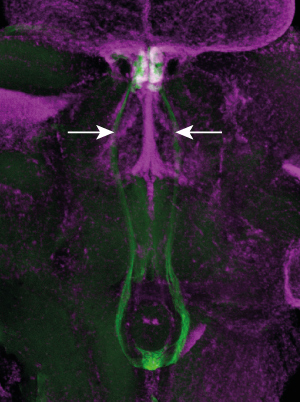Mar. 27, 2015 Research Highlight Biology
The pathway to avoiding danger
A pathway in the brain that helps zebrafish learn to avoid danger could be involved in panic disorders
 Figure 1: A slice of zebrafish brain showing bilateral axonal projections (green) from the ventral habenula to the median raphe (indicated by arrows). © 2015 Hitoshi Okamoto, RIKEN Brain Science Institute
Figure 1: A slice of zebrafish brain showing bilateral axonal projections (green) from the ventral habenula to the median raphe (indicated by arrows). © 2015 Hitoshi Okamoto, RIKEN Brain Science Institute
In all animals there are brain mechanisms to ensure that a perception of danger elicits a panic response. For long-term species survival, however, a better strategy is to learn to avoid danger. Research led by Hitoshi Okamoto from the RIKEN Brain Science Institute has now revealed mechanisms in the brain that are involved in avoidance learning, and which may also be involved in human psychological disorders1.
The research team focused on a brain signal pathway called the habenulo-raphe pathway. In mammals, this pathway allows communication between an area of the brain called the lateral habenula, which is activated by aversive or trepidatious events, and another region called the raphe nucleus, which releases a chemical called serotonin.
“Anticipation of punishment can become a source of motivation to learn how to avoid danger,” explains Okamoto. “We suspected that the habenulo-raphe pathway may be necessary for this type of learning.”
To test this hypothesis, the team studied the equivalent pathway in zebrafish, which connects the ventral habenula to the median raphe (Fig. 1). They recorded the activity of neurons in the ventral habenula while fish were trained in an active avoidance task. The fish first learned to link a red light as a visual cue, with a danger, in this case, a mild electric shock. They learned to avoid the danger by swimming to a different compartment of the tank.
Okamoto and his colleague, Ryunosuke Amo, identified two sets of neurons in the ventral habenula that responded differently to the visual cue. Activity in the first set increased with repeated trials, indicating that it represents the fish’s expectation of danger. By contrast, activity in the second set diminished with repeated trials, indicating that it represents the error between the fish’s expectation and the actual outcome. However, during avoidance learning, activity in the first set of neurons also decreased, because as the fish learned to avoid the danger, so the expectation of danger decreased.
The researchers also found that activity in the ventral habenula leads to activity in the median raphe. By blocking communication between the two regions, the habenulo-raphe pathway was found to be essential for active avoidance learning.
“Zebrafish with impairment of the habenulo-raphe pathway can associate the incoming danger with the presented cue, but cannot learn how to adaptively avoid the danger,” explains Okamoto. “This behavior is similar to that in patients with panic disorder. Our study may help the development of treatments for such psychiatric disorders.”
References
- 1. Amo, R., Fredes, F., Kinoshita, M., Aoki, R., Aizawa, H., Agetsuma, M., Aoki, T., Shiraki, T., Kakinuma, H., Matsuda, M. et al. The habenulo-raphe serotonergic circuit encodes an aversive expectation value essential for adaptive active avoidance of danger. Neuron 84, 1034–1048 (2014). doi: 10.1016/j.neuron.2014.10.035
